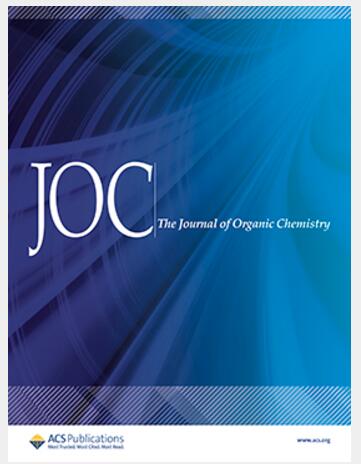利用金(I)催化的分子内氢化芳基化反应模拟某些烯丙基化吲哚生物碱的异构体Pyrano[2,3-g]吲哚和Pyrano[3,2-f]吲哚核的可能生物遗传途径
IF 3.6
2区 化学
Q1 CHEMISTRY, ORGANIC
引用次数: 0
摘要
在所谓的烯丙基化吲哚生物碱(PIAs)中,有相当一部分含有一个角熔合的吡喃[2,3-g]吲哚核,而少数则含有异构体和线性熔合的吡喃[3,2-f]吲哚核。为了探索分子内氢化反应(IMHA)的能力,以允许选择性形成这些基序中的一个或另一个,制备了一系列在C1-C3取代基性质不同的6-((2-甲基-3-yn-2-基)氧)- 1h -吲哚,并与一系列金(I)催化剂进行了反应。在每一个例子中,优先(但不是排他)形成的角度熔融吡喃[2,3-g]吲哚异构体被观察到。即使C2和C3取代基与天然产物PIA家族关键成员的取代基越来越相似,情况也是如此。这些IMHA方案已应用于天然产物(±)-1、(±)-2、(±)-3、(±)-4、25和26的全合成。讨论了这些研究可能的生物合成意义。本文章由计算机程序翻译,如有差异,请以英文原文为准。
![Modeling Possible Biogenetic Pathways to the Isomeric Pyrano[2,3-g]indole and Pyrano[3,2-f]indole Cores of Certain Prenylated Indole Alkaloids Using Gold(I)-Catalyzed Intramolecular Hydroarylation Reactions](https://img.booksci.cn/booksciimg/2025-2/2025022610468390905043.png)
Modeling Possible Biogenetic Pathways to the Isomeric Pyrano[2,3-g]indole and Pyrano[3,2-f]indole Cores of Certain Prenylated Indole Alkaloids Using Gold(I)-Catalyzed Intramolecular Hydroarylation Reactions
A significant subset of the so-called prenylated indole alkaloids (PIAs) contains an angularly fused pyrano[2,3-g]indole core, while a smaller number embody the isomeric and linearly fused pyrano[3,2-f]indole one. In an effort to probe the capacities of intramolecular hydroarylation (IMHA) reactions to allow for the selective formation of one or other of these motifs, a series of 6-((2-methylbut-3-yn-2-yl)oxy)-1H-indoles varying in the nature of the substituents at C1–C3 was prepared and subjected to reaction with a range of gold(I) catalysts. In every instance, preferential (but not exclusive) formation of the angularly fused pyrano[2,3-g]indole isomer was observed. This was so even as the C2 and C3 substituents increasingly resembled those associated with key members of the PIA family of natural products. These IMHA protocols have been deployed in the total syntheses of the natural products (±)-1, (±)-2, (±)-3, (±)-4, 25, and 26. The possible biosynthetic implications of these studies are discussed.
求助全文
通过发布文献求助,成功后即可免费获取论文全文。
去求助
来源期刊

Journal of Organic Chemistry
化学-有机化学
CiteScore
6.20
自引率
11.10%
发文量
1467
审稿时长
2 months
期刊介绍:
Journal of Organic Chemistry welcomes original contributions of fundamental research in all branches of the theory and practice of organic chemistry. In selecting manuscripts for publication, the editors place emphasis on the quality and novelty of the work, as well as the breadth of interest to the organic chemistry community.
 求助内容:
求助内容: 应助结果提醒方式:
应助结果提醒方式:


